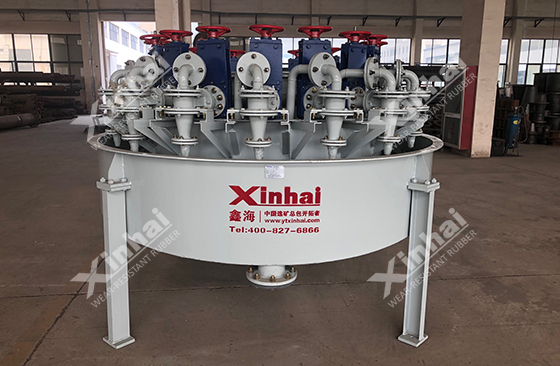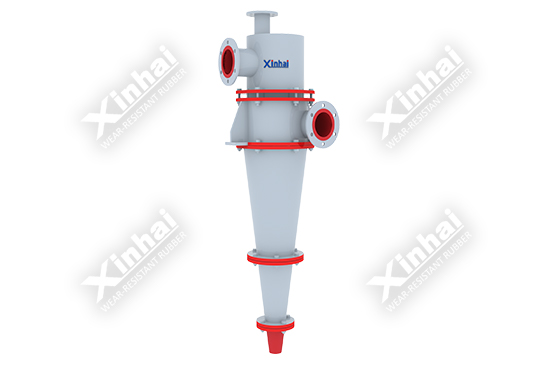
The hydrocyclone is an effective fine-grain classification equipment in the current mineral processing equipment. In daily production, the hydrocyclone more or less will have some problems. If it cannot be found and solved in time, it is likely to lead to hydrocyclone stop operation. So, what are the common problems of hydrocyclone in daily operation? How should we solve these failures? Now, let’s analyze the causes and countermeasures.
In the production process, the feed pressure will affect the processing capacity and classification size of hydrocyclone. Usually, the feed pressure of hydrocyclone should be kept stable according to the required pressure and should not produce large fluctuations, otherwise it will damage the performance of the equipment and affect its classification effect. The reason of the large fluctuation of the feed pressure is that the liquid level of pump tank drops or air tracing causing insufficient ore feeding to the pump, or the blockage of debris in the pump. If the hydrocyclone is operated for a long time, the decrease in feed pressure is mainly caused by the wear and tear of the pump.
Solution:
1) If the feed pressure fluctuation is caused by the drop of the pump tank liquid level, it can be adjusted by increasing the liquid level, or closing one or two cyclones, or reducing the pump speed.
2) If the feed pressure fluctuation is caused by the pump blockage or wear, the pump needs to be repaired.

Judging whether the hydrocyclone is blocked is mainly determined by observing whether the overflow and underflow discharge of the hydrocyclone in operation are smooth. When there are more coarse particles in the overflow, the flow of the overflow and the underflow is reduced, or the underflow is cut off. When the sediment is discharged in the form of columns, it indicates that the hydrocyclone has been blocked. In addition, if the hydrocyclone has a long time of violent shaking, it also indicates that the hydrocyclone is blocked.
Solution:
1) If the overflow and underflow are reduced, the feed port of the hydrocyclone may be blocked. At this time, the feed valve of the hydrocyclone should be closed and removed to clear the blockage.
2) If the underflow is reduced or cut off, the underflow port is blocked. In this case, the flange can be removed to clear the debris in the underflow port.
3) In order to prevent blockage, the hydrocyclone group can be set up in the feed pool to prevent coarse materials and debris facilities (such as debris sieve). At the same time, the feed pool should be emptied in time when it is out of service, so as to avoid driving again so as not to cause blockage due to precipitation and high concentration when restart the hydrocyclone.

During operation, the hydrocyclone operator needs to frequently observe the underflow discharge state of the hydrocyclone, and regularly check the underflow concentration and fineness. If the underflow concentration fluctuates or “underflow contains fine particles”, it should be adjusted in time. Under normal working conditions, the underflow discharge of the hydrocyclone should be "umbrella-shaped". If the concentration of the underflow is too large, the underflow will be discharged in the “columnar” or intermittently “lumpy” shape.
Solution:
1) The high concentration of underflow may be caused by the feed slurry concentration or the underflow port is too small, which can add an appropriate amount of water to the feed first. If the underflow concentration is still high, it needs to replace a larger underflow port.
2) If the underflow is discharged in an "umbrella shape", but the underflow concentration is less than the production required concentration, it may be caused by the low feed concentration. In this case, the feed concentration should be increased.
3) The “underflow contains fine particles” may be caused by the underflow port wear, too large diameter of underflow port too small diameter of overflow pipe, too high or too low pressure. It is necessary to adjust the pressure first, and then check whether the underflow port is worn or replace a larger one and gradually debug to normal production status.

uring the operation, the hydrocyclone operator also needs to regularly check the concentration and fineness of the overflow from the cyclone. The increase of overflow concentration or “overflow turning coarse” is usually caused by the increase of feed ore concentration and the blockage of the underflow.
Solution:
1) When finding “overflow turning coarse”, it’s better to check whether the underflow port is blocked first, and then check the feed concentration, and then adjust according to the specific situation. If the underflow port is blocked, open the underflow port to clear the blockage.
2) If the overflow concentration is small and the fineness is fine, or the small grit nozzle can be replaced to meet the requirements.

Under normal circumstances, the hydrocyclone riffling is discharged in the umbrella shape. The riffling angle is between 10°-20°, and the concentration reaches about 75%, which is the ideal working state of the hydrocyclone. If the grit nozzle is spray-shaped, the large angle of the grit indicates that the grit nozzle is too large. If the grit nozzle is rope-shaped, it might because the concentration of the feed ore is too high, the size of the grit nozzle is too small, the grit nozzle is partially blocked or the slurry density is too low.
Solution:
1) When the grit nozzle is spray-shaped, it can be adjusted by replacing the small grit nozzle;
2) When the grit nozzle is rope-shaped, the size of the grit nozzle can be appropriately increased, and the cyclone should be stopped to clean up the blockage.
The above are the reasons and countermeasures for common problems of hydrocyclones. In addition to choosing the type of equipment that meets the processing process, daily maintenance and repair are also important if you want the equipment to run stably and efficiently. It is recommended to consult with professional hydrocyclone manufacturers when purchasing, and comprehensively consider the process and equipment of the concentrator to further improve the work efficiency and economic benefits of the concentrator.
To find out more about our products and solutions, please fill out the form below and one of our experts will get back to you shortly.